This article originally appeared in the Fall 2024 issue of EquiManagement. Sign up here for a FREE subscription to EquiManagement’s quarterly digital or print magazine and any special issues.

Tall fescue is a cool-season, perennial plant that derives a good bit of its robustness from a mutualistic relationship with an endophyte living between the plant cells. The fescue plant protects the endophyte’s hyphae, while the endophyte provides stress tolerance and pest deterrence to make the plant tougher and more durable. At the University of Kentucky (UK) Equine Veterinary Continuing Education seminar, Krista Lea, MS, research analyst at UK’s Plant and Soil Sciences Department, addressed the concerning topic of fescue toxicosis in broodmares and how to manage fescue pasture.
Fescue Toxicosis in Broodmares
The endophytes produce a chemical called ergovaline, an ergot alkaloid that has known adverse effects on pregnant mares. Common clinical signs include prolonged gestation by two to three weeks; this delay often means foals get bigger with potential risk of dystocia. Other common signs include a thickened retained placenta that is difficult for a foal to break through, leading to red bag; very low to no milk production; and a possibility of late-term abortion. An older study (1987) compared the effects of endophyte-infected fescue vs. endophyte-free fescue on pregnant mares and their foals. Twenty mares were split into two groups. Each mare carried her foal to term, but the 11 mares on endophyte-free forage had no foaling problems whereas all 11 mares exposed to endophyte-infected forage had problems. Only one of those mares produced milk; 3/11 foals were born alive; and three mares died.
Fescue Toxicosis Prevention Strategies
Reduce Ergovaline Exposure
Lea recommends several means to combat these potential problems. The first is to reduce ergovaline exposure by considering grazing height, because endophytes are not distributed evenly through the plant. Stem and seedheads have more concentrated amounts—by mowing spring pastures, it is possible to remove the stems and seedheads and prevent sprouting of seeds with ergovaline. In addition, the bottom 3 inches of the plant have the highest concentration of ergovaline, even more than stems and seeds, because the endophyte lives most of the year at the base of the plant. Knowing this allows one to avoid stocking horses in heavily grazed pastures that harbor the most toxic plant parts.
Dilute Diet With Nontoxic Forage
A second strategy relies on diluting the diet with nontoxic forage. This can be accomplished by putting horses in a drylot with no plants and only feeding good-quality hay. Or, a grazing muzzle can be used to reduce the volume of pasture intake. She notes this only works if the horses are provided with good-quality hay; otherwise, they might limit hay intake and wait until turnout to graze pasture. Another possibility is to keep favorable grasses in pasture by maintaining good soil fertility and to graze pastures rotationally to maintain appropriate plant height. Also, effective weed control sprayed at the appropriate time window improves grass quality, as does an appropriate stocking density of at least two acres of pasture per horse. When overseeding, she recommends the best time to do this is in the fall.
Remove Tall Fescue Completely
A third option is to remove tall fescue from the system altogether. A product called Plateau provides targeted removal of fescue without killing bluegrass or orchard grass. She notes that favorable grasses will yellow initially. It takes six to eight weeks to kill off the fescue, but there are no grazing restrictions after the initial few days post-spray, Lea said. However, this is a short-term solution that might decrease overall pasture quality from weeds filling in once fescue is gone. With weed control and over time, orchard grass or bluegrass eventually fill in.
Use a Novel Endophyte Tall Fescue
A better option yet is the use of a novel endophyte tall fescue. Endophyte-free fescue is tempting; however, these plants don’t survive more than four to five years. Instead, a novel endophyte tall fescue produces alkaloids to make the plants tougher but without the toxic ergot alkaloids. In studies, researchers have seen no difference in any variable tested between mares grazing the novel endophyte fescue pasture and mares grazing orchard grass-bluegrass pasture. It is important to ask for one of seven varieties of novel endophyte tall fescue when ordering to ensure you don’t end up buying endophyte-free fescue.
Additional Resources
Find more information on pasture management at forages.ca.uky.edu/equine. Workshops on novel tall fescue renovation workshops are available at grasslandrenewal.org.
Related Reading
- Strategies for Reducing Early Embryonic Loss in Mares
- Diagnosing Causes of Equine Abortion
- How To Manage the Late-Gestation/High-Risk Mare in the Field
Stay in the know! Sign up for EquiManagement’s FREE weekly newsletters to get the latest equine research, disease alerts, and vet practice updates delivered straight to your inbox.


![[Aggregator] Downloaded image for imported item #18383](https://s3.amazonaws.com/wp-s3-equimanagement.com/wp-content/uploads/2025/09/30141253/EDCC-Unbranded-29-scaled-1-768x512.jpeg)

